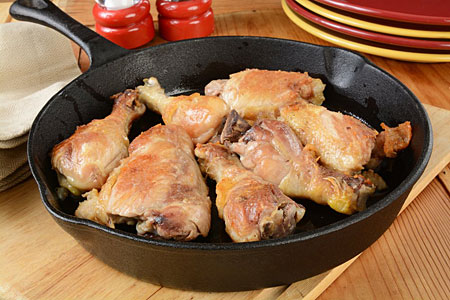
Homegrown chicken can be more flavorful than any other kind. But if you make any of the following mistakes, you may end up serving something unpalatable or even unsafe. Avoid these 5 common mistakes when cooking chicken:
Thawing Frozen Chicken
When you plan to cook frozen chicken, thaw it in the refrigerator for a day or two. Simply leaving it on the kitchen counter for a few hours can be awfully tempting. But it can cause pathogenic organisms to flourish that cooking might not destroy. Therefore someone eating the chicken could get sick.
If you really need to thaw chicken in a hurry, put it in a zipper bag and cover the bag with cold tap water. Every half hour replace the water with fresh cold tap water until the chicken is thawed, but no more than 2 hours. A whole chicken, or a bag of parts, that takes longer than two hours to thaw is risking the pathogen problem.
The fastest way to thaw frozen chicken is in a microwave. However, the thawed chicken should be cooked immediately, as some spots will be warm enough to allow pathogens to flourish. Besides, the quality of the cooked chicken won’t be nearly as good as with the other two methods. Your chicken took time growing, right? So give it a little extra time to thaw in a way that preserves its texture and flavor.
Frying Chicken
Chicken pieces fried together in the same pan should all be pretty close to the same size. If you try to fry parts of different sizes together, the smaller, thinner parts will cook faster than the larger, thicker parts. As a result, the small pieces may end up overcooked, while the larger pieces are still too raw.
One of the more common mistakes when cooking chicken is to crowd the parts in the skillet, which also results in uneven cooking. Chicken parts fried in a skillet will brown nicely when the individual pieces don’t touch.
Roasting Chicken
A whole roasted chicken should be tender and juicy. But it won’t be if you move it straight from the oven to the cutting board.
While the chicken is roasting in the oven, its juices migrate toward the outer skin. Cutting into it as soon as it leaves the oven lets the juices leak out, causing the meat to be dry. If you wait 15 minutes before slicing into the chicken, the juices will have time to redistribute throughout the meat, resulting in much better flavor and texture.
Marinating Chicken
A marinade can moisten chicken, tenderize it, and add flavor. But leaving chicken in any marinade for too long can cause the meat’s proteins to break down. The result is an unpalatable chicken with a too-soft texture. In most cases, chicken needs to be marinated for only 30 minutes for small pieces, and no more than 2 hours for chicken of any size.
To avoid proliferation of pathogens, always marinate chicken in the fridge. When the time is up, remove the chicken and discard the marinade. Don’t save it to reuse for another chicken dish. If you wish to use marinade to baste the chicken while it cooks, set some aside where it never comes into contact with raw chicken.
Stewing Chicken
Old chickens are sometimes called stewing hens, because they’re cooked in liquid to soften the meat. But stewing isn’t the same as boiling. Bringing the liquid to a boil actually has the opposite effect: it tightens the chicken meat, which ends up tough and chewy.
Stewing involves a long, slow simmer, rather than a fast boil. If you aren’t sure what a simmer is, use a thermometer and aim for a temperature of between 180ºF and 190ºF. Or, better yet, pop the chicken into a slow cooker and let the appliance do the rest.
Avoid these 5 mistakes when cooking chicken, and that homegrown bird you so carefully brought to harvest will make a mighty fine meal.
Helpful Links
Meat and Broiler Chickens Offered by Cackle Hatchery®
Which Is Best for Meat: Cornish Broiler or Heritage Breed?
Raising Cornish Cross Hens? Try This Delicious Recipe at Home!
And that’s today’s news from the Cackle Coop.
Gail Damerow has written numerous poultry-keeping books, including Storey’s Guide to Raising Chickens.

